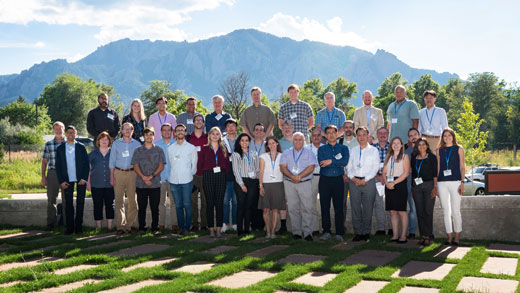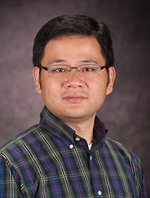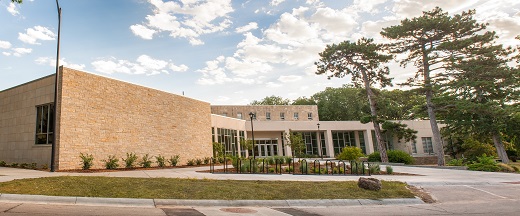07/31/19
K-State Current - July 31, 2019
K-State Current is a weekly news update for the Kansas Board of Regents to apprise the Regents on a few of the many successes and achievements made by K-State faculty, staff and students. 
K-State News
New $2.7 million NIH grant extends researcher's work on tick-borne disease
 The research team for Roman Ganta, center, focuses on learning more about the tick-borne disease human monocytic ehrlichiosis caused by the pathogenEhrlichia chaffeensis. From left are Maria Dolores Juarez-Rodriguez, Chandramouli Kondethimmanahalli, Huitao Liu, Ascencion Torres-Escobar, Swetha Madesh, Deborah Jaworski, Arathy DS Nair and Ying Wang. Not pictured are Paidashe Hove and Xishuai Tong.
The research team for Roman Ganta, center, focuses on learning more about the tick-borne disease human monocytic ehrlichiosis caused by the pathogenEhrlichia chaffeensis. From left are Maria Dolores Juarez-Rodriguez, Chandramouli Kondethimmanahalli, Huitao Liu, Ascencion Torres-Escobar, Swetha Madesh, Deborah Jaworski, Arathy DS Nair and Ying Wang. Not pictured are Paidashe Hove and Xishuai Tong.
The clock could be ticking for ticks. Roman Ganta, Kansas State University professor and director of the Center of Excellence for Vector-Borne Diseases in the College of Veterinary Medicine, recently secured a new grant of $2.7 million from the National Institutes of Health to continue his longtime work on tick-borne disease.
Previously, Ganta's research team has received grants from the NIH's Research Project Grant Program of $1.8 million, $1.825 million and $1.687 million in 2014, 2007 and 2002 respectively. The target of Ganta's research is human monocytic ehrlichiosis, which is caused by the tick-transmitted pathogenEhrlichia chaffeensis.
"Tick-borne diseases remain a growing public health concern for more than four decades in the U.S. and many other parts of the world," said Ganta, a professor of diagnostic medicine and pathobiology. "My team's prior studies have demonstrated that this pathogen, which also infects dogs, changes many of its expressed proteins as per its growth in a vertebrate host and in the tick host. We have also been active in studying the immune response required to protect a host from the disease. Substantial progress made during the prior five-year funded cycle is the key to landing another five years of support from the NIH."
Funded by the NIH since 2002, Ganta said his team's research has aided in the development of novel genetic methods useful in understanding pathogenesis and vaccine development. With an additional five years of support through the new grant, his tick-borne disease research program will mark 22 years of continuous NIH funding.
Ganta plans to continue investigating how Ehrlichia chaffeensis regulates its gene expression in response to host cell environmental signals and how it develops strategies to evade host response for its continued survival in vertebrate hosts and ticks.
"We have goals set for the next five years to investigate how the pathogen changes its protein expression by investigating gene regulation at the molecular level," Ganta said. "This mechanism defines the functional significance of proteins that have been identified as essential for E. chaffeensisgrowth in animals and ticks. We will perform numerous protein function disruption experiments aimed at understanding the critical determinants of the bacterium that causes the disease in people and animals from the bite of an infected lone star tick."
Moving forward, Ganta anticipates making substantial progress toward understanding how this and other tick-borne diseases are successful in causing persistent infections in animals and people. He said that his team is also focused on the development of effective vaccines to prevent the spread of human monocytic ehrlichiosis and other important tick-borne diseases impacting the health of people, companion animals and agricultural animals.
Workshop provides insight on next-generation ceramic composites for aerospace industry
 Building on a successful workshop from last year, Kansas State University hosted the second polymer-derived ceramics workshop July 15-19 in Boulder, Colorado. The workshop, which is funded through a National Science Foundation Partnerships for International Research and Education grant, was organized by Gurpreet Singh, associate professor of mechanical and nuclear engineering in the Carl R. Ice College of Engineering.
Building on a successful workshop from last year, Kansas State University hosted the second polymer-derived ceramics workshop July 15-19 in Boulder, Colorado. The workshop, which is funded through a National Science Foundation Partnerships for International Research and Education grant, was organized by Gurpreet Singh, associate professor of mechanical and nuclear engineering in the Carl R. Ice College of Engineering.
Singh, principal investigator, was awarded the grant for his work on polymer-derived ceramics to create "super" turbines. The grant is currently in its second year, with funding available for five years.
The workshop seminars covered topics in the field of polymer-derived ceramics, high temperature ceramic matrix composite materials, additive manufacturing of polymer composites, polymer-derived ceramics for energy storage, and ultrahigh temperature materials for aerospace applications.
Of the 45 members of academia in attendance, one member of the National Academy of Sciences, Alexandra Navrotsky; one member of the National Academy of Inventors, Raj N. Singh; and two members of the National Academy of Engineering, David Marshall and Ray Baughman, were present. The aerospace industry was represented by attendees from Boeing, Spirit AeroSystems, General Electric, and Pratt and Whitney — United Technologies. Several attendees from Spain, France, Italy, Germany, South Korea and Japan were present at the workshop. Academia and industry had ample opportunities to network; academics were able to describe their research, while industry attendees were able to communicate their manufacturing needs. A key focus area of the workshop was to find ways to translate academic research to meet industrial needs.
Five of the 15 students at the workshop were from the Alan Levin Department of Mechanical and Nuclear Engineering at Kansas State University. One of the five K-State students was Sophia Justus, a Partnerships for International Research and Education undergraduate scholar. She took part in a summer research internship at the University of Montpellier, France. Justus' summer research focused on 3D printing of ceramic materials. Workshop attendees were able to learn about student research and internship experiences during a poster session. It was a memorable experience for students as they were able to network with people who work in their field from across the globe. Students were able to discuss internship programs, postdoctoral positions and job openings with faculty and industry members.
The workshop was designed to take a break from science, with day trips to Rocky Mountain National Park for hiking, and Lyons for a bluegrass music festival. The attendees came away with a renewed sense of vigor and a refreshed mindset.
"I am very excited for the future of polymer-derived ceramics and the camaraderie that being part of such a huge collaboration brings," Singh said.
Singh thanks Darren Dawson, former dean of the college, and Gary Clark, interim dean of the college, for leadership and vision. The next generation of students interested in polymer-derived ceramics can look to Singh and his team to mentor them in the right direction.
K-State Faculty Highlights
 Zhilong Yang, an assistant professor in the Division of Biology, is the principal investigator on a new, nearly $1.9 million grant from the National Institutes of Health. The five-year project will study how vaccinia virus — a member of the poxvirus family — produces its proteins. This award is from the Research Project Grant Program, usually referred to as R01, and is considered the bread and butter grant of the NIH for biomedical researchers.
Zhilong Yang, an assistant professor in the Division of Biology, is the principal investigator on a new, nearly $1.9 million grant from the National Institutes of Health. The five-year project will study how vaccinia virus — a member of the poxvirus family — produces its proteins. This award is from the Research Project Grant Program, usually referred to as R01, and is considered the bread and butter grant of the NIH for biomedical researchers.
The NIH has continuously supported Yang's research on vaccinia virus through multiple awards in the past five years, when he opened his laboratory at K-State, including a Pathway to Independence award, an Exploratory/Developmental grant award and a Centers for Biomedical Research Excellence project, in addition to the R01 award. Yang's group has made a series of remarkable discoveries on this topic.
Vaccinia virus was used as the vaccine to eradicate smallpox, one of the deadliest infectious diseases in human history. Both vaccinia virus and variola virus, the latter is the causative agent of smallpox, belong to a large family of virus called poxvirus. Although smallpox was eradicated 40 years ago, many members of poxviruses currently cause significant public health issues in humans and economically important animals. There is also a concern that smallpox may arise from unknown stocks or other means.
But poxviruses do not always cause harm. In fact, many poxviruses, including the vaccinia virus that Yang is studying, can be used to fight other human and animal diseases. For example, vaccinia virus can serve as a carrier for developing vaccines to fight many other human and animal infectious diseases. A number of currently used veterinary vaccines are generated based on vaccinia virus.
Vaccinia virus, along with many other poxviruses, also has tremendous potential in fighting cancers, because it can selectively kill tumor cells. By engineering the virus to be less harmful to healthy tissues but to kill tumors more efficiently, scientists are developing highly promising new cancer therapeutics.
This grant will help Yang and his colleagues in his laboratory to answer a fundamental question: How does vaccinia virus produce viral proteins? This is an important question to understand how the virus amplifies itself, as proteins are building blocks to make viral particles. Interestingly, viruses do not have the machinery to make proteins by themselves. Instead, they must use their hosts' protein-making machinery. This makes the question even more intriguing: how does the virus redirect the host protein-making machinery to produce viral proteins after infection?
Answers to this fundamental question could provide new strategies to block poxvirus infection and improve the efficacy of poxviruses used in vaccine development and cancer therapy.
Interior design professor named One to Watch by national organization
 Georges Fares, professor of interior design, has received the One to Watch award from the American Society of Interior Designers.
Georges Fares, professor of interior design, has received the One to Watch award from the American Society of Interior Designers.
To be eligible for the award, nominees must have 5-15 years of experience in the interior design industry; be actively employed in the interior design industry; on a path to a senior and/or executive-level position in the interior design industry; and belong to an underrepresented group in industry management roles, including women, members of racial and ethnic minority groups, LGBTQ and persons with disabilities.
Fares received his master's degree in interior design from the University of Texas at Austin. He has more than eight years of experience designing and implementing private and public design projects in various countries in the Levant, Europe, the Gulf region and North America. His designs seek to aid people with physical and mental difficulties. His most recent project, which examines the different ways architecture and space could be engaged in treating and minimizing the obstacles of autism spectrum disorder on children's daily lives, has won him several recognitions and awards. Fares also is investigating effective methods of combining robotics and cutting-edge technology with design to positively influence the behavior and daily lives of minority groups with special needs. He joins the K-State faculty after working as a self-employed interior architect for nine years.
The American Society of Interior Designers is the oldest, largest and only multidisciplinary professional organization for interior designers, interior design students and the manufacturers and suppliers who support the profession.
K-State Student News
K-State doctoral student named to 40 under 40 list by InvestmentNews
 Miranda Reiter, online doctoral student in personal financial planning at K-State, was named to InvestmentNews' 40 under 40 list, which aims to recognize young, talented individuals doing remarkable things in the financial advice industry.
Miranda Reiter, online doctoral student in personal financial planning at K-State, was named to InvestmentNews' 40 under 40 list, which aims to recognize young, talented individuals doing remarkable things in the financial advice industry.
Selected from nearly 1,000 nominees, Reiter currently works as a financial advisor with USAA where she serves military members and their families in addition to her doctoral coursework. Her goal is to combine her love of teaching and research to further advance the diversity and inclusion of women and minorities in the financial advice industry.
"The work advisors do is very practice-oriented, and we tend to look at things from our direct experience," Reiter told InvestmentNews. "Research helps us see what's happening from a larger perspective. It brings a different level of insight to inform their practices and it makes the industry stronger."
This award isn't the first for Reiter, who also was recognized for her diversity efforts by being awarded the Financial Planning Association Diversity Scholarship in 2018. Recipients of the merit-based scholarship are professionals working to encourage diversity, serve diverse communities and increase the professional opportunities for diverse communities within the financial planning profession. Reiter's work with the military community, as well as volunteer work with the elderly, women, college students and African Americans, among other groups, helped her to stand out among her peers.
InvestmentNews has served as a source for news, analysis and information essential to the financial advisory community since 1998. Publications include a weekly newspaper, website, newsletters, research, events, videos and webcasts.
Read more about Reiter's award on the InvestmentNews website.